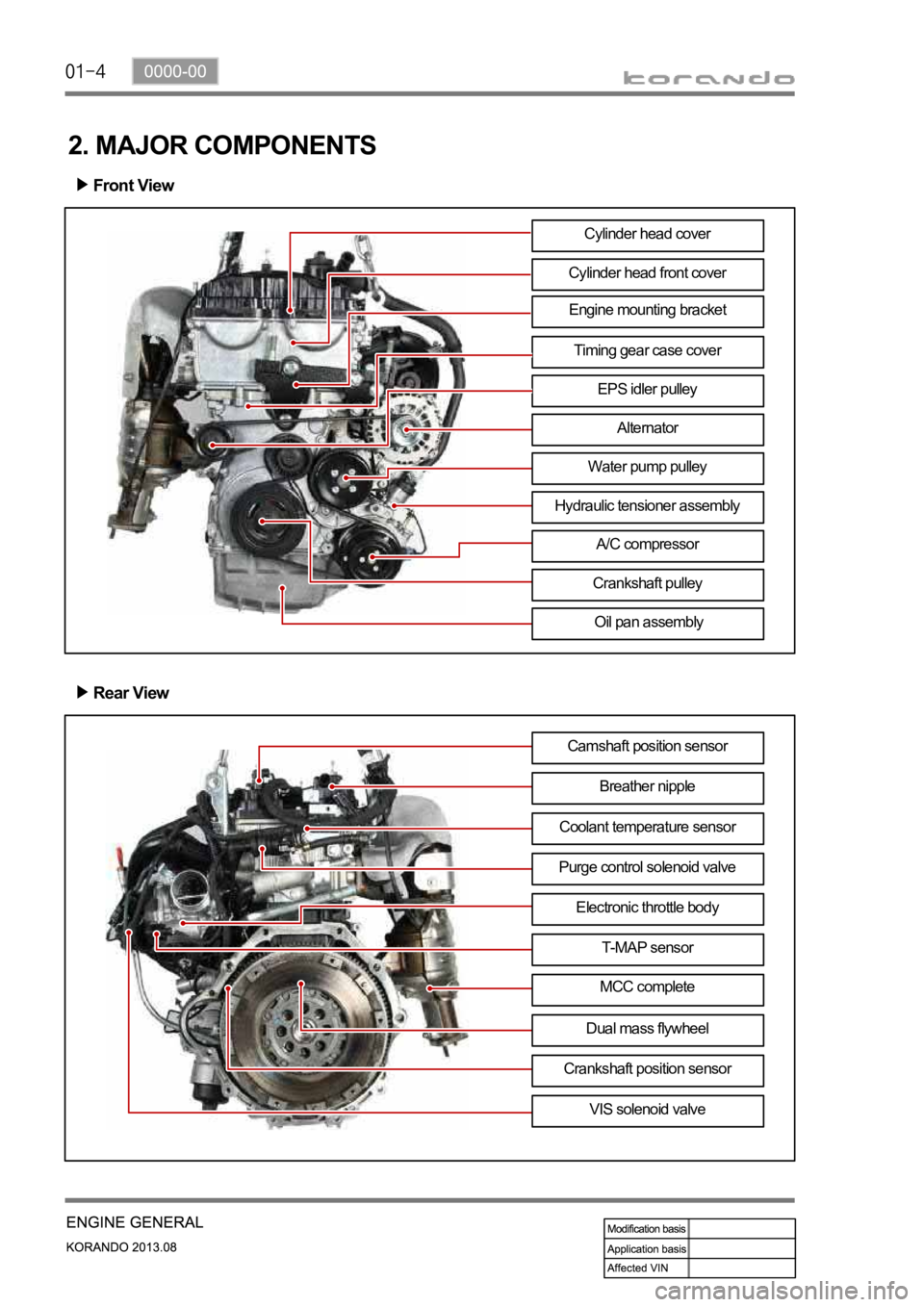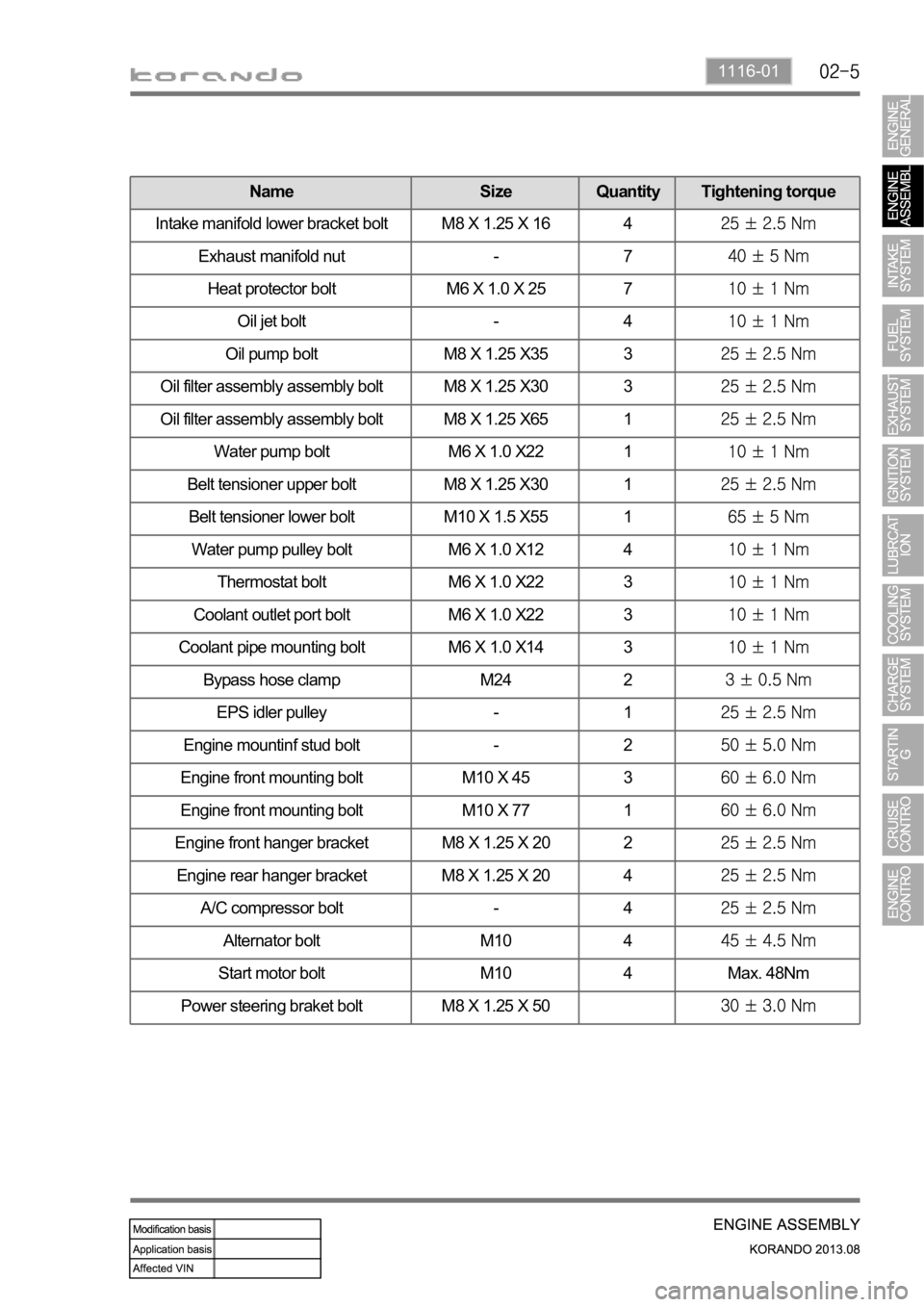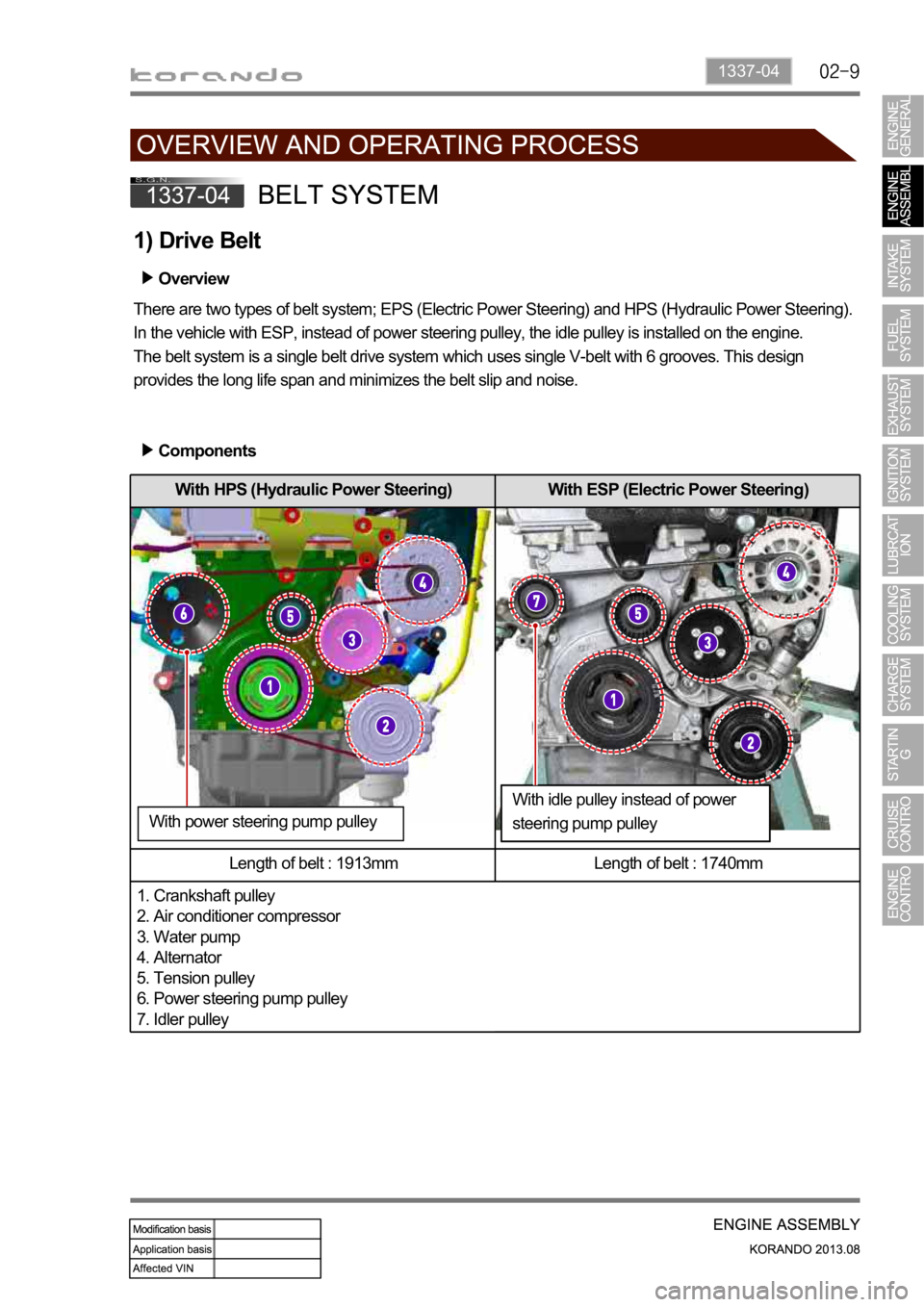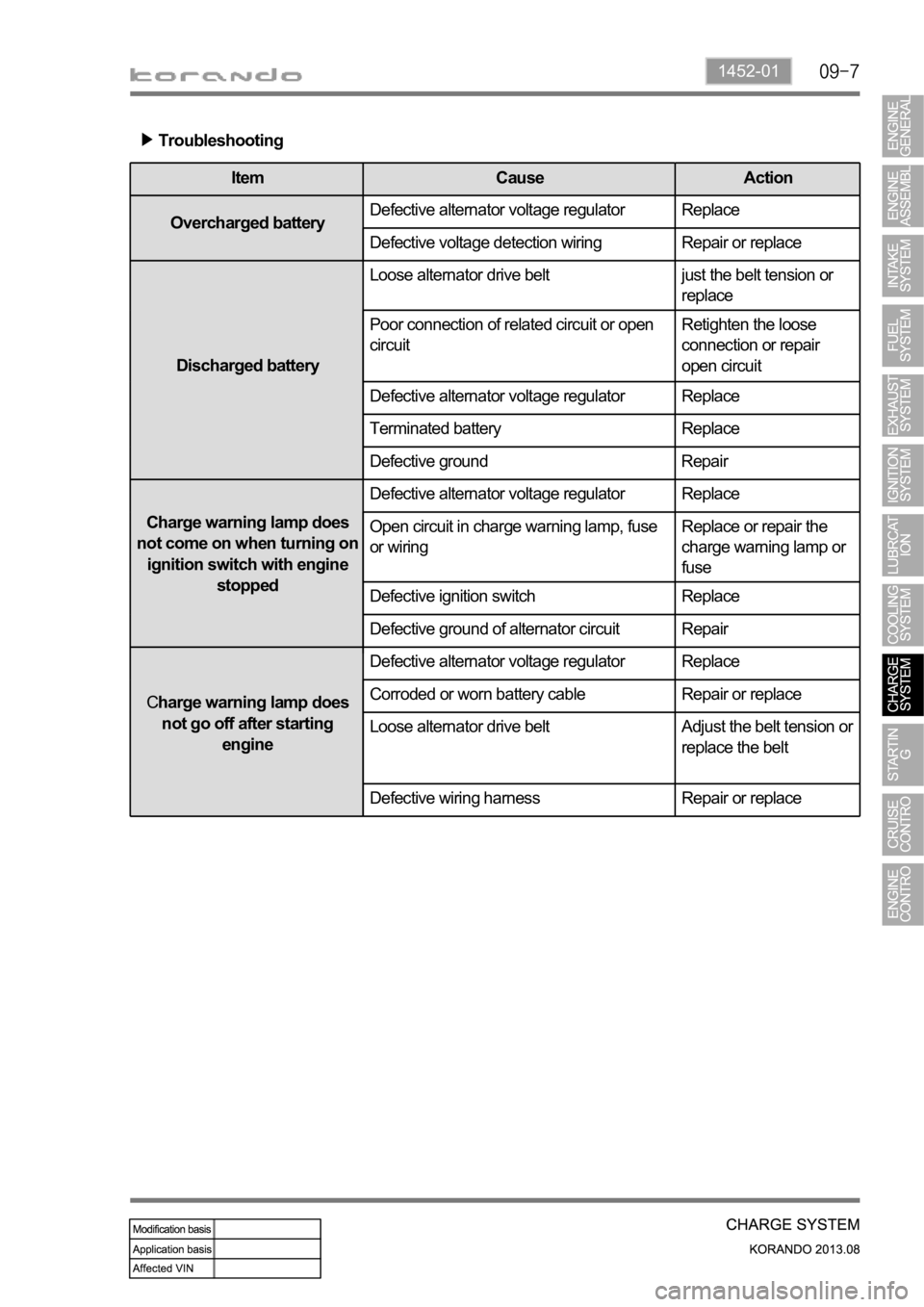alternator SSANGYONG KORANDO 2013 User Guide
[x] Cancel search | Manufacturer: SSANGYONG, Model Year: 2013, Model line: KORANDO, Model: SSANGYONG KORANDO 2013Pages: 1336, PDF Size: 92.18 MB
Page 408 of 1336

0000-00
PTC heater
Coolant
temp. sensor
D20DTF
ECU
Engine room relay box
HFM
(Intake air
temp.)
(9) PTC heater control
a. Overview
The supplementary electrical heater is installed in DI engine equipped vehicle as a basic equipment. The
PTC system is operated according to two temperature values measured at the coolant temperature
sensor and HFM sensor. This device is mounted in the heater air outlet and increase the temperature of
air to the passenger compartment. Because PTC system is heated by electrical power, high capacity
alternator is required. PTC does not operate during engine cranking, while the battery voltage is lower
than 11 V or during preheating process of glow plugs.
b. Components
A: PTC 1 (changeable)
B: PTC 2,3 (not changeable)
Page 423 of 1336

Engine mounting bracket
2. MAJOR COMPONENTS
Front View
Cylinder head front cover
Timing gear case cover
EPS idler pulley
Alternator
Water pump pulley
A/C compressor
Crankshaft pulley
Oil pan assembly
Rear View
Camshaft position sensor
Breather nipple
Purge control solenoid valveCoolant temperature sensor
Electronic throttle body
T-MAP sensor
MCC complete
VIS solenoid valve Cylinder head cover
Dual mass flywheel
Crankshaft position sensor
Hydraulic tensioner assembly
Page 438 of 1336

1116-01
Name Size Quantity Tightening torque
Intake manifold lower bracket bolt M8 X 1.25 X 16 4
Exhaust manifold nut - 7
Heat protector bolt M6 X 1.0 X 25 7
Oil jet bolt - 4
Oil pump bolt M8 X 1.25 X35 3
Oil filter assembly assembly bolt M8 X 1.25 X30 3
Oil filter assembly assembly bolt M8 X 1.25 X65 1
Water pump bolt M6 X 1.0 X22 1
Belt tensioner upper bolt M8 X 1.25 X30 1
Belt tensioner lower bolt M10 X 1.5 X55 1
Water pump pulley bolt M6 X 1.0 X12 4
Thermostat bolt M6 X 1.0 X22 3
Coolant outlet port bolt M6 X 1.0 X22 3
Coolant pipe mounting bolt M6 X 1.0 X14 3
Bypass hose clamp M24 2
EPS idler pulley - 1
Engine mountinf stud bolt - 2
Engine front mounting bolt M10 X 45 3
Engine front mounting bolt M10 X 77 1
Engine front hanger bracket M8 X 1.25 X 20 2
Engine rear hanger bracket M8 X 1.25 X 20 4
A/C compressor bolt - 4
Alternator bolt M10 4
Start motor bolt M10 4 Max. 48Nm
Power steering braket bolt M8 X 1.25 X 50
Page 442 of 1336

1337-04
With HPS (Hydraulic Power Steering) With ESP (Electric Power Steering)
Length of belt : 1913mm Length of belt : 1740mm
1. Crankshaft pulley
2. Air conditioner compressor
3. Water pump
4. Alternator
5. Tension pulley
6. Power steering pump pulley
7. Idler pulley
1) Drive Belt
Overview
There are two types of belt system; EPS (Electric Power Steering) and HPS (Hydraulic Power Steering).
In the vehicle with ESP, instead of power steering pulley, the idle pulley is installed on the engine.
The belt system is a single belt drive system which uses single V-belt with 6 grooves. This design
provides the long life span and minimizes the belt slip and noise.
Components
With idle pulley instead of power
steering pump pulley With power steering pump pulley
Page 526 of 1336

1452-01
1. SPECIFICATION
Unit Description Specification
AlternatorType HPS EPS
Crankshaft pulley : Alternator pulley 1 : 2.66
Normal output
(idle/2200rpm)70/140A
Regulator voltage 12V
BrushLength 12.5mm
Wear limit 7.0mm
BatteryType MF
Capacity 90AH
Page 527 of 1336

2. LAYOUT
1) Alternator
Alternator assembly
Bolt 1.
2.
Page 529 of 1336

Item How to check DTC set value / Action
Output current
B terminal current
Rotor coil
resistance
L terminal voltage
3. INSPECTION
1) Alternator
Output Test
Disconnect the cable connected to the B
terminal on the alternator. Connect one
end of the ammeter to the B terminal and
the other end to the cable connected to
the B terminal.
Measure the maximum output value.
(Maintain the engine speed between
2,500 and 3,000 rpm.)
(Turn the headlamp and all the electrical
switches on.) 1.
2.Pass: If the measured current
is 45 A or higher.
Fail: If the measured current is
less than 45 A.
Check the current of the B
terminal. -
-
-
Move the gear selector lever to the neutral
position.
Maintain the engine speed at 2,500 rpm
with the vehicle unloaded.
(Turn all the electrical switches off.) 1.
2.Open circuit: If the measured
current is 5 A or higher. -
Disconnect the negative cable from the
battery.
Remove the B terminal and turn off the
ignition switch.
Measure the resistance between the L
and F terminals with an ohmmeter. 1.
2.
3.Pass: If the measured
resistance is between 3 and
Faulty rotor coil or slip ring: If
the measured resistance is
-
-
Connect the B terminal wiring.
Measure the voltage with the engine
running. 1.
2.
Specification: 12.5V to 14.5V
Faulty IC regulator or field
coil: If the measured voltage
is 14.5V or higher. -
-
Disconnect the negative cable from the battery.
Connect the negative cable again after connecting the ammeter. -
-
Page 530 of 1336

1452-01
Troubleshooting
Item Cause Action
Overcharged batteryDefective alternator voltage regulator Replace
Defective voltage detection wiring Repair or replace
Discharged batteryLoose alternator drive belt
just the belt tension or
replace
Poor connection of related circuit or open
circuitRetighten the loose
connection or repair
open circuit
Defective alternator voltage regulator Replace
Terminated battery Replace
Defective ground Repair
Charge warning lamp does
not come on when turning on
ignition switch with engine
stoppedDefective alternator voltage regulator Replace
Open circuit in charge warning lamp, fuse
or wiringReplace or repair the
charge warning lamp or
fuse
Defective ignition switch Replace
Defective ground of alternator circuit Repair
Charge warning lamp does
not go off after starting
engineDefective alternator voltage regulator Replace
Corroded or worn battery cable Repair or replace
Loose alternator drive belt
Adjust the belt tension or
replace the belt
Defective wiring harness Repair or replace
Page 532 of 1336

1452-01
Using battery tester
PASS (11.0 V or more): Explain to the customer that the battery is reusable.
Need to be charged (9.0 to 11.0 V): Charge the battery with a charger and reinstall it. Explain it to the
customer.
Need to be replaced (9.0 V or more): The battery should be replaced due to overdischarging. -
-
-
How to use battery tester
Determine battery capacity by fixing current
(load capacity) and time and varying voltage.
Determine battery capacity based on the
amount of voltage drop when discharging a
fixed load capacity (120 A) for 5 seconds.
Connect the tester to the battery and read the
display while applying a load for 5 seconds. -
-
-
battery
(using a vehicle alternator and a battery
charger)
Impossible to charge with an alternator
Red area on the right-hand side of OK
-
-
-
-
-
-
-
Page 535 of 1336

Battery
It converts the chemical energy to the
electrical energy and supplies power to the
corresponding electric units when starting the
engine.
1. OVERVIEW
The charge system is designed to supply electrical energy to the vehicle while driving, and supplies a
constant direct current voltage by converting mechanical rotational movement to electrical energy. The
voltage regulator on the back of the alternator controls the generated voltage in all rotating ranges and
adjusts the system voltage according to the electric load and ambient temperature change.
Body ground
B+ wiringAlternator
The alternator charges the battery and
supplies power to each electric unit by
converting the mechanical energy to the
electrical energy.